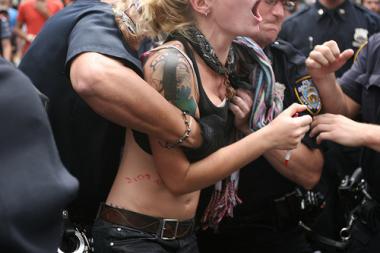The verdict in the biggest Occupy related criminal case in New York City, that of Cecily McMillan, came down Monday afternoon. As disturbing as it is that she was found guilty of felony assault against Officer Grantley Bovell, the circumstances of her trial reflect an even more disturbing reality – that of normalized police violence, disproportionately punitive sentences (McMillan faces seven years in prison), and a criminal penal system based on anything but justice. While this is nothing new for the over-policed communities of New York City, what happened to McMillan reveals just how powerful and unrestrained a massive police force can be in fighting back against the very people with whom it is charged to protect.
McMillan was one of roughly 70 protesters arrested on March 17, 2012. She and hundreds of other activists, along with journalists like me, had gathered in Zuccotti Park to mark the six-month anniversary of the start of Occupy Wall Street. It was four months after the New York Police Department had evicted the Occupy encampment from the park in a mass of violent arrests.
When the police moved in to the park that night, in formation and with batons, to arrest a massive number of nonviolent protesters, the chaos was terrifying. Bovell claimed that McMillan elbowed him in the face as he attempted to arrest her, and McMillan and her defense team claim that Bovell grabbed her right breast from behind, causing her to instinctively react.
But the jury didn't hear anything about the police violence that took place in Zuccotti Park that night.
They didn't hear about what happened there on November 15, 2011, when the park was first cleared. The violence experienced by Occupy protesters throughout its entirety was excluded from the courtroom. The narrative that the jury did hear was tightly controlled by what the judge allowed – and Judge Ronald Zweibel consistently ruled that any larger context of what was happening around McMillan at the time of the arrest (let alone Bovell's own history of violence) was irrelevant to the scope of the trial.
In the trial, physical evidence was considered suspect but the testimony of the police was cast as infallible.
Despite photographs of her bruised body, including her right breast, the prosecution cast doubt upon McMillan's allegations of being injured by the police – all while Officer Bovell repeatedly identified the wrong eye when testifying as to how McMillan injured him. And not only was Officer Bovell's documented history of violent behavior deemed irrelevant by the judge, but so were the allegations of his violent behavior that very same night
To the jury, the hundreds of police batons, helmets, fists, and flex cuffs out on March 17 were invisible – rendering McMillan's elbow the most powerful weapon on display in Zuccotti that night, at least insofar as the jury was concerned.
That hyper-selective retelling of events to the jury mirrored the broader popular narrative of OWS. The breathtaking violence displayed by the NYPD throughout Occupy Wall Street has not only been normalized, but entirely justified – so much so that it doesn't even bear mentioning.
After the police cleared the park that night, many of the remaining protesters went on a spontaneous march, during which a group of officers slammed a street medic's head into a glass door so hard the glass splintered. It is the only instance of which I know throughout New York City's Occupy movement where a window was broken.
Still, it is the protesters who are remembered as destructive and chaotic. It is Cecily McMillan who went on trial for assault but not Bovell or any of his colleagues – despite the thousands of photographs and videos providing irrefutable evidence that protesters, journalists and legal observers alike were shoved, punched, kicked, tackled, and beaten over the head. That mindset was on display during the jury selection process at McMillan's trial, when juror after juror had to be dismissed because of outright bias against the Occupy movement and any of its participants.
It's impossible to understand the whole story by just looking at it one picture, even if it's McMillan's of her injuries. But that is exactly what the jury in McMillan's case was asked to do. They were presented a close up of Cecily McMillan's elbow, but not of Bovell, and asked to determine who was violent.
The prosecutors and the judge prohibited them from zooming out.
This is, of course, how police brutality is presented to the public every day, if it is presented it at all: an angry cop here, a controversial protester here, a police commissioner who says the violence of the NYPD is "old news". It's why #myNYPD shocked enough people to make the papers – because it wasn't one bruised or broken civilian body or one cop with a documented history of violence. Instead, it was one after another after another, a collage that presented a more comprehensive picture – one of exceptionally unexceptional violence that most of America has already accepted.


